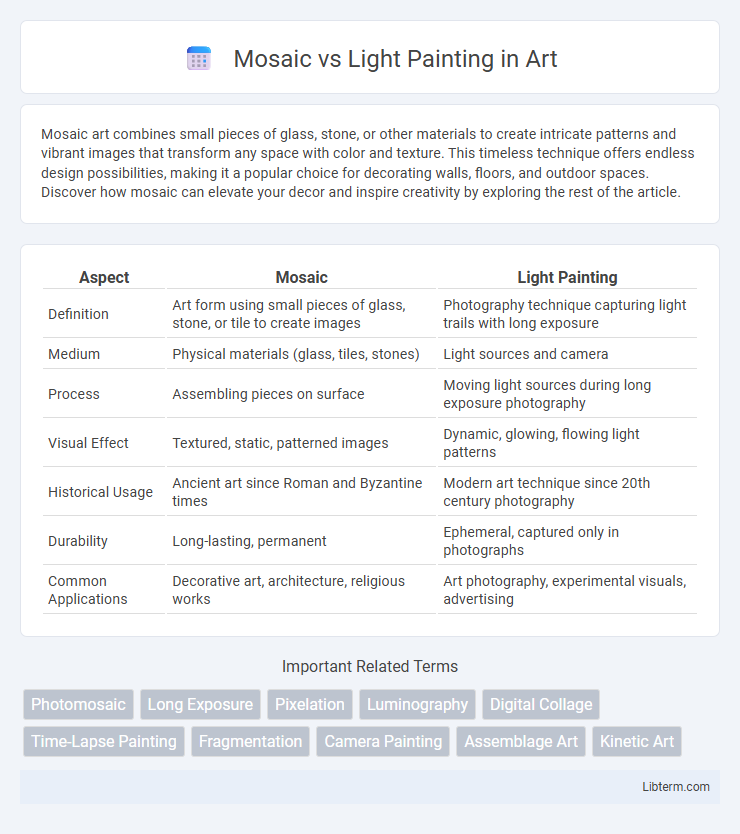Mosaic art combines small pieces of glass, stone, or other materials to create intricate patterns and vibrant images that transform any space with color and texture. This timeless technique offers endless design possibilities, making it a popular choice for decorating walls, floors, and outdoor spaces. Discover how mosaic can elevate your decor and inspire creativity by exploring the rest of the article.
Table of Comparison
| Aspect | Mosaic | Light Painting |
|---|---|---|
| Definition | Art form using small pieces of glass, stone, or tile to create images | Photography technique capturing light trails with long exposure |
| Medium | Physical materials (glass, tiles, stones) | Light sources and camera |
| Process | Assembling pieces on surface | Moving light sources during long exposure photography |
| Visual Effect | Textured, static, patterned images | Dynamic, glowing, flowing light patterns |
| Historical Usage | Ancient art since Roman and Byzantine times | Modern art technique since 20th century photography |
| Durability | Long-lasting, permanent | Ephemeral, captured only in photographs |
| Common Applications | Decorative art, architecture, religious works | Art photography, experimental visuals, advertising |
Introduction to Mosaic and Light Painting
Mosaic art involves creating images or patterns through assembling small pieces of colored glass, stone, or other materials, emphasizing texture and durability in design. Light painting is a photographic technique that captures moving light sources in long-exposure photos, producing dynamic and abstract visual effects. Both art forms explore unique methods of visual expression, with mosaic focusing on static composition and light painting on temporal motion.
Defining Mosaic Art
Mosaic art involves creating images or patterns by assembling small pieces of colored glass, stone, or other materials, often used in architectural decoration. This form of visual expression emphasizes tesserae placement and the interplay of light and texture to achieve detailed, durable compositions. Unlike light painting, which uses dynamic light exposure to create ephemeral visuals, mosaic art is a static, tactile medium grounded in craftsmanship and historical tradition.
Understanding Light Painting Photography
Light painting photography captures trails of light in long-exposure images, creating dynamic and fluid visuals, while mosaics assemble small, static images or pieces to form a larger, cohesive picture. Understanding light painting involves mastering camera settings like shutter speed, aperture, and ISO to control exposure time, allowing moving light sources to be captured vividly against dark backgrounds. Techniques include using handheld light sources such as LED lights, sparklers, or flashlights to "paint" in the air, contrasting with mosaics' reliance on fixed elements arranged in patterns.
Historical Origins: Mosaic vs Light Painting
Mosaic art traces its origins to ancient Mesopotamia and Rome, where small pieces of stone, glass, or ceramics were meticulously assembled to create intricate images and patterns. Light painting emerged in the early 20th century as photographic technology advanced, with artists using long exposure techniques to manipulate light sources and create dynamic, luminous images. The contrast between mosaic's static, tactile craftsmanship and light painting's ephemeral, camera-based expression highlights distinct historical pathways in visual art development.
Materials and Tools Required
Mosaic creation requires materials such as ceramic tiles, glass pieces, grout, adhesive, and a mesh backer, along with tools like tile cutters, tweezers, and spatulas for precise placement. Light painting involves equipment including a camera with manual exposure settings, light sources like LED wands, flashlights, or glow sticks, and sometimes tripods to stabilize the camera during long exposure shots. Both crafts depend on specialized tools tailored to manipulate their respective materials, whether solid tesserae for mosaics or dynamic light patterns for light painting.
Techniques Compared: Mosaic and Light Painting
Mosaic technique involves assembling small, colored pieces of glass, stone, or tile to create intricate, static images with detailed texture and pattern. Light painting uses long-exposure photography to capture moving light sources, producing dynamic, luminous visuals that emphasize motion and fluidity. Both techniques require precision, but mosaics focus on physical composition and permanence, whereas light painting emphasizes temporal creativity and ephemeral effects.
Artistic Expression and Creative Possibilities
Mosaic art offers intricate detail and texture through the arrangement of small, colored pieces to create a cohesive image, emphasizing precision and pattern in artistic expression. Light painting enables dynamic and fluid creativity by capturing long-exposure photographs of moving light sources, allowing artists to experiment with motion, color, and time in unique ways. Both techniques push creative possibilities by transforming traditional visual boundaries into immersive and innovative art forms.
Popular Uses and Applications
Mosaic art is popular in architectural decoration, educational projects, and historical restorations, often seen in public spaces and cultural landmarks. Light painting is widely used in creative photography, advertising, and event entertainment to produce dynamic visual effects and capture time-lapse movements. Both techniques enhance visual storytelling but serve different artistic and commercial purposes, with mosaics providing durable, tactile surfaces and light painting offering ephemeral, luminous imagery.
Challenges and Limitations
Mosaic art demands meticulous precision and significant time investment to align thousands of small tiles or pieces into a coherent design, often limiting flexibility in spontaneous creativity. Light painting faces challenges such as the need for controlled lighting environments and long exposure photography techniques, which can hinder capturing detailed imagery in dynamic or outdoor settings. Both mediums have constraints in scalability and detail resolution, with mosaics limited by physical material size and light painting restricted by camera technology and environmental factors.
Choosing Between Mosaic and Light Painting
Choosing between mosaic and light painting depends on the desired visual impact and project context. Mosaic art offers detailed, textured compositions built from small, durable pieces ideal for permanent installations, while light painting provides dynamic, luminous effects suitable for ephemeral, photographic creations. Evaluating factors like setting, longevity, and audience engagement helps determine the optimal artistic approach.
Mosaic Infographic

 libterm.com
libterm.com